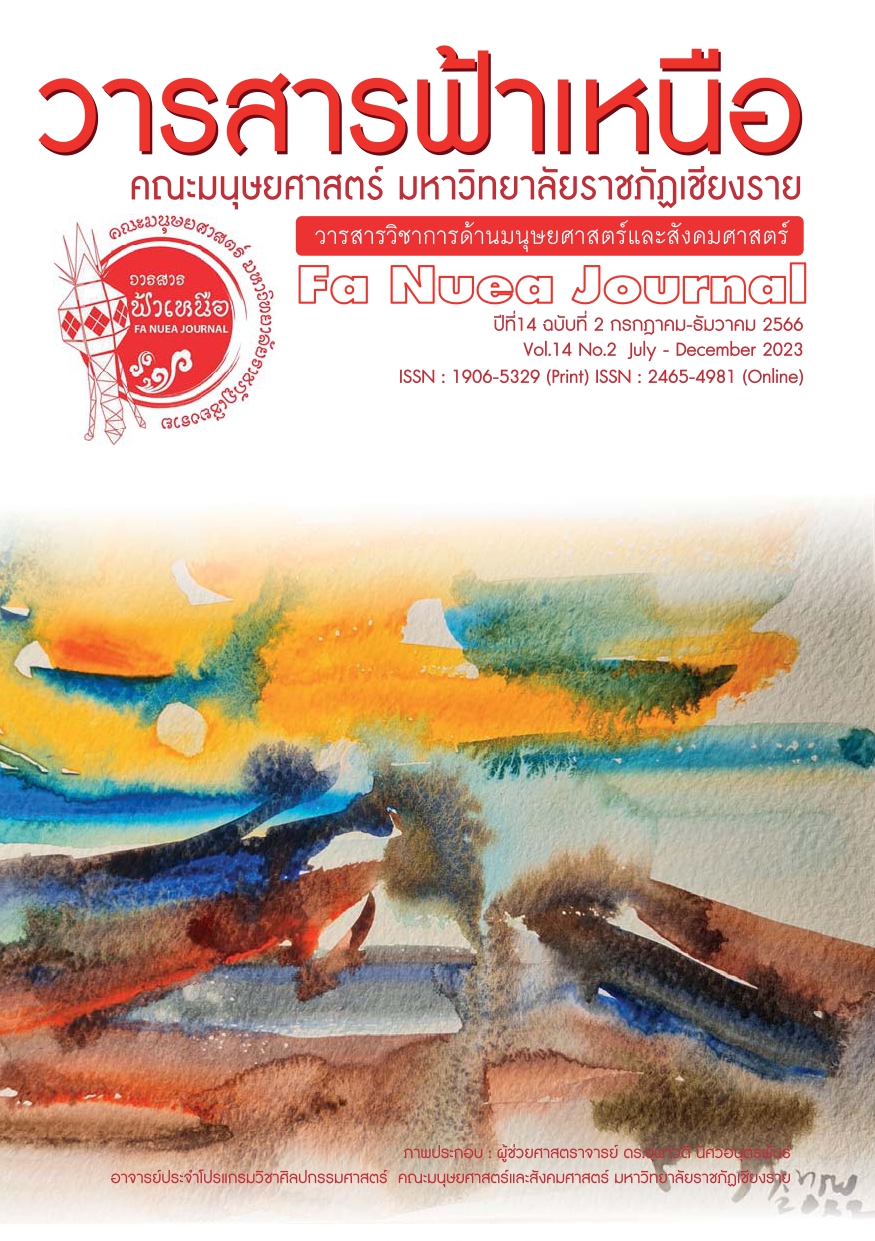Cognitive Processes for the Semantic Mappings of Mandarin Chinese
Main Article Content
Abstract
The purpose of this study is to analyze the cognitive process for the semantic mapping of nine basic color terms in Mandarin Chinese: 白 bái [WHITE], 黑 hēi [BLACK], 红 hóng [RED], 绿 lǜ [GREEN], 黄 huáng [YELLOW], 蓝 lán [BLUE], 粉 fěn [PINK], 紫 zǐ [PURPLE], and 灰 huī [GREY] into other domains. The data are collected from Beijing Language and Culture University Corpus (BCC语料). The study reveals that metonymy, metaphor, and metaphtonymy, which is identified as a special process that specifies the interaction between metaphor and metonymy, are three cognitive processes that are used for the semantic mapping of basic color terms in Mandarin Chinese into other domains. In addition, metonymy is the most frequently used in cognitive processes, followed by metaphor and metaphtonymy. This study can also be applied to Chinese language instruction in teaching about the figurative meaning of Mandarin Chinese basic color terms.
Article Details

This work is licensed under a Creative Commons Attribution-NonCommercial-NoDerivatives 4.0 International License.
Articles, information, content, pictures, etc. which have been published in Fa Nuea Journal, are copyright of Fa Nuea Journal. If any person or party wishes to disseminate all or part of it or take any action must be referenced. Do not use for commercial purposes and do not modify (CC-BY-NC-ND). For further details, please access at Attribution-NonCommercial-NoDerivatives 4.0 International (CC BY-NC-ND 4.0)
References
กรมวิชาการเกษตร. (2559, 19 กุมภาพันธ์). เชื้อราฟิวซาเรียมออกซี่สปอรัมสาเหตุโรคเหี่ยวของพืช. DOA Thailand. https://shorturl.asia/BIyN9
ธนัฏฐากุล พรทิพยพานิช. (2563). คำเรียกสีที่ใช้เปรียบเทียบเชิงประวัติในภาษาไทยตามแนวทางภาษาศาสตร์ปริชาน [วิทยานิพนธ์ปริญญาปรัชญาดุษฏีบัณฑิต ไม่ได้ตีพิมพ์]. มหาวิทยาลัยศรีนครินทรวิโรฒ.
ธีรารัตน์ จับใจนาย และ อรทัย ชินอัครพงศ์. (2564). อรรถศาสตร์ปริชานของคำเรียกชื่อสัตว์ในภาษาไทยถิ่นเหนือ จังหวัดเชียงราย. วารสารสันติศึกษาปริทรรศน์ มจร, 11(1), 95-105.
นฤมล ศิริพันธุ์. (2554). คำเรียกสีและทัศนคติที่มีต่อสีของผู้พูดภาษาไทย กะเหรี่ยงโปว์ มอญ และขมุ ในอำเภอศรีสวัสดิ์ จังหวัดกาญจนบุรี [วิทยานิพนธ์ปริญญาอักษรศาสตรมหาบัณฑิต ไม่ได้ตีพิมพ์]. มหาวิทยาลัยศิลปากร.
สุชยา เกษจำรัส. (2562, 27 กรกฎาคม). เขินอายแล้วหน้าแดงกันมั้ย?. Beartai. https://www.beartai.com/brief/sci-news/346797
Ashish. (2022, July 26) Why Does Your Face Turn Pale When You’re Scared?. Science ABC. https://shorturl.asia/AGJp4
Gao, J., & Sutrop, U. (2014). The Basic Color Terms of Mandarin Chinese. Studies in Language, 38(2), 335-359.
Goossens, L. (1990). Metaphtonymy: The Interaction of Metaphor and Metonymy in Expressions for Linguistic Action. Cognitive Linguistics, 1(3), 323-342.
Kövecses, Z. (2010). Metaphor: A Practical Introduction Second Edition (2 nd ed.). Oxford University Press.
Lakoff, G. (1987). Woman, Fire and Dangerous Things: What Categories Reveal about the Mind. The University of Chicago Press.
Panther, K. U., & Radden, G. (1999). Introduction. In K. U. Panther & G. Radden (Eds.), Metonymy in Language and Thought. John Benjamins Publishing.
Ruiz de Mendoza Ibáñez, F. J., & Diez Velasco, O. I. (2002). Patterns of conceptual interaction. In R. Dirven & R. Porings (Eds.), Metaphor and Metonymy in Comparison and Contrast (pp. 489-532). Berlin; New York: Mouton de Gruyter.
Vyvyan, E., Benjamin, B., Jörg, Z. (2007). The Cognitive Linguistics Reader. Equinox Press.


